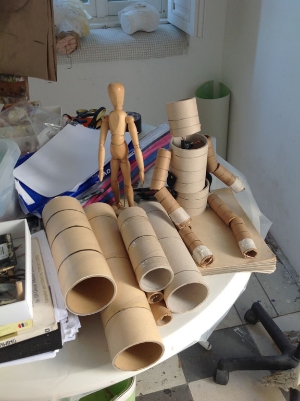Being a teacher means entering into a position of trust with the student. Creative arts involve risk taking and the expansion of potential as well as self development. In order for a transformation to occur the student and teacher need a high level of mutual respect. Sometimes this relationship comes easily and at other times it is hard won. I teach in incremental steps as the beginning student needs a clear foundation of technique and vocabulary on which to build knowledge. The more advanced student benefits from this approach as well but can put the learning to use more quickly and with more depth than the beginner. It is the teacher's job to be aware of each student's needs and to recognize and acknowledge their level. A teacher mirrors the student, guiding or nudging where needed. Teachers can wound if they are insensitive to the student's pace and boundaries. As a teacher I try to help the student to find purpose and make critical decisions as they will require this discipline if they are to continue in the arts. I stumbled into teaching some years after graduate school giving classes at a community center in Cincinnati. I was asked to teach figure drawing and batik. I knew nothing about batik but being in front of a class is a great motivator to learn a subject. Every year I teach new information and this keeps the learning fresh. Students offer huge amounts of knowledge themselves and they have taught me as much as I have them. The most important ingredient in good teaching is to treat the student as an equal and a co-creator in their artistic development. A saying I try to honor: "A Master is someone who started before you did."
Figure drawing at The Aegean Center
Some of the tools I have developed for my classes include: the perspective clock, a see-through clock face with cross hairs to read angles: a box figure, affectionately named Carlotta, which can show contraction and expansion of the main parts of the human form: and a series of dance leotards on which I have drawn cross contour lines, muscles and plane breaks for the model to wear.
I developed many exercises for the painting class which help to break the difficult art of oil painting into simpler steps. When I see students struggle I know I haven't explained the process correctly. When they paint easily and joyfully their success means the work I've put into the exercise has paid off. Exercises free both the student and the teacher to reach deeply into the process as shared vocabulary and the parameters of the problem are understood and mastered before moving on to another concept. Exercises do not stifle creativity, in fact just the opposite occurs. Creativity is infinite play in a limited space, and without some containment of possibilities chaos can quickly overtake the process. Give an exercise to twenty five students and you have twenty five solutions. Without parameters the same twenty five students' work tend to show the same amateur approaches and faults: mixing muddy colors, pushing far and near objects to the same plane, no control of the edges, and haphazard brushwork. With specific exercises awareness is brought to all these issues quickly and the student moves ahead to more complex ideas.
“Better to choose a limit capriciously than to have none.”


